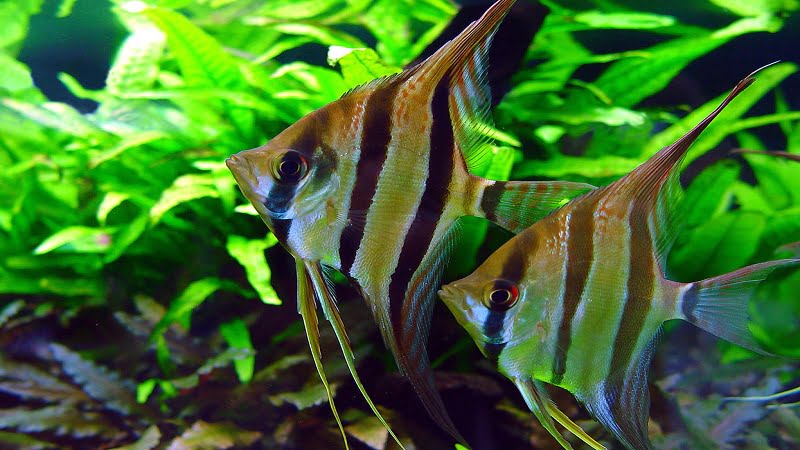“Angelfish” term can refer to both freshwater and marine angelfish (saltwater angelfish). In this article, I will focus on freshwater angelfish.
Freshwater angelfish belong to the cichlid family and are one of the favorite fish in the aquarium trade owing to their unique arrowhead bodies with beautiful, flowing fins. This fish is native to the Amazon River Basin, is hardy, a big eater, and compatible with numerous freshwater fish.
The freshwater angelfish is generally recognized as a peaceful species that can get along with many other freshwater fish. But they can get aggressive, fight with their mates in the same species, and prey upon smaller fish, especially during the breeding season.
Related Articles
- Do Angelfish Like To Hide? 7 Reasons Will Answer All Your Wonders
- Do Angelfish Get Lonely? – 3 Things You Need To Know
- Do Angelfish Fight And 6 Ways To Make Them Stop Fighting With Others
- Do Angelfish Jump? – 6 Reasons And 6 Ways To Stop Them Jumping Out Of Their Tank
Overview
- Scientific name: Pterophyllum
- Species: Pterophyllum scalare, Pterophyllum altum, Pterophyllum leopoldi
- Origin: Amazon River Basin
- Distribution: South America, mainly near the Amazon River and Orinoco Basin
- Care level: Easy to moderate
- Temperament: Semi-Aggressive
- Size: 6-10 inches
- Lifespan: Up to 10 years
- Minimum tank size: 30 gallons
- Diet: Flakes, pellets, worms, shrimp, veggies
- Breeding: Egg layer
- Compatibility: Large, peaceful fish; semi-aggressive fish; schooling fish too large to eat
Angelfish are carnivorous species that feed on both small fish and macroinvertebrates. All species of Pterophyllum form monogamous pairs. Most of the time, the females lay eggs on submerged logs or flattened leaves. They are often striped transversely in the wild, making good additional camouflage for them.
It is important to distinguish Pterophyllum from the marine angelfish – perciform fish belong to the family Pomacanthidae and inhabit shallow reefs in the tropical western Pacific Ocean.
Origin & Habitat
Pterophyllum is usually referred to as freshwater angelfish, a small genus of freshwater fish in the family Cichlidae. All Pterophyllum species come from tropical South America’s Amazon Basin, Orinoco Basin, and rivers in the Guiana Shield.
In the wild, their habitats are floodplains, swamps, and similar slow-moving water bodies. In their habitats, the water quality is between clear and silty water.
The characteristic of their habitat is swampy with a sandy riverbed and lots of vegetation. They prefer dense vegetation regions since these areas are best for them to prey and hide from predators.
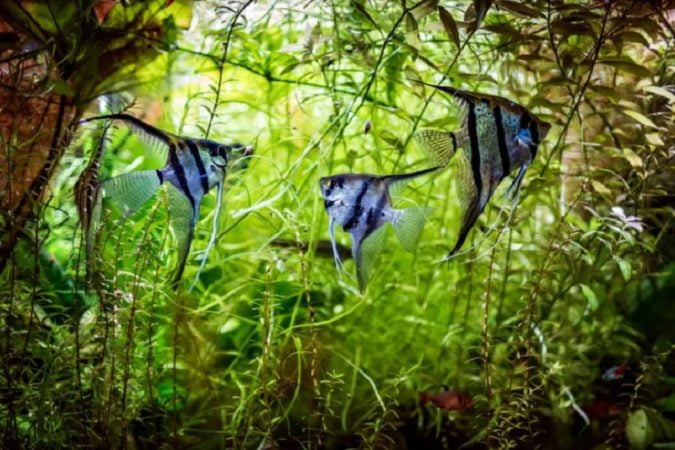
Species & Distribution
The currently recognized species in this genus are Pterophyllum altum, Pterophyllum leopoldi, and Pterophyllum scalare.
- Pterophyllum altum: Their common names are the altum angelfish, deep angelfish, or Orinoco angelfish. They can be found in the Orinoco River Basin and the Upper Rio Negro watershed in Southern Venezuela, Southeastern Colombia, and extreme Northern Brazil.
Read more: Altum Angelfish Care Guide
- Pterophyllum leopoldi: This species is also known as teardrop angelfish, Leopold’s angelfish dwarf angelfish, or roman-nosed angelfish. They are an angelfish species native to the Amazon River (between Manacapuru and Santarém), Essequibo River, and Rupununi River.
- Pterophyllum scalare: This species is typically referred to as angelfish or freshwater angelfish, and is the most popular captive-bred species of Pterophyllum. They are native to the Amazon Basin in Peru, Colombia, and Brazil.
These Pterophyllum species differ greatly from other cichlids in shape. They have round bodies and triangular dorsal and anal fins. Their body shapes help them easily hide among roots and plants, often on vertical surfaces.
Appearance
All angelfish have large bodies and triangular noses and mouths. Their caudal fins are fan-shaped while dorsal and pectoral fins are long and flowing. Usually, they have silver coloration with black stripes, but they can present other color varieties due to selection in captive breeding.
Typically, Pterophyllum has 7 black stripes on their bodies, but this number decreases as they age. Other colors that angelfish come in include gold, black, white, orange, and yellow.
The color intensity of an angelfish depends on their mood and stress levels. Particularly, angelfish often appear duller in color when under stress or asleep. Meanwhile, they will exhibit vibrant coloration when being in good water conditions and well-fed to stay healthy.
Additionally, sex differences between angelfish are hard to tell until they are almost ready to breed. In their breeding season, the male angelfish often display bolder colors than usual to attract the females.
Types of Angelfish
Domestic angelfish stocks have undergone several mutations and have become genetically fixed strains.
Depending on the species of angelfish, pairing two of the same species may result in all offspring being of the same species. Meanwhile, cross-breeding, or pairing two different varieties, will result in other angelfish variations.
Moreover, the traits of offspring produced from an angelfish pair are most likely to be determined by the fish with dominant traits.
Here are some of the more popular types of freshwater angelfish.
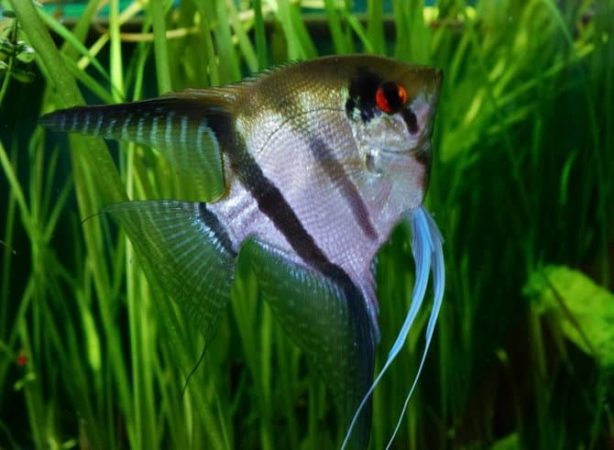
Silver: The silver angelfish is the same color as the wild angelfish. It is silver in color with red eyes. The side is adorned with three vertical black stripes.
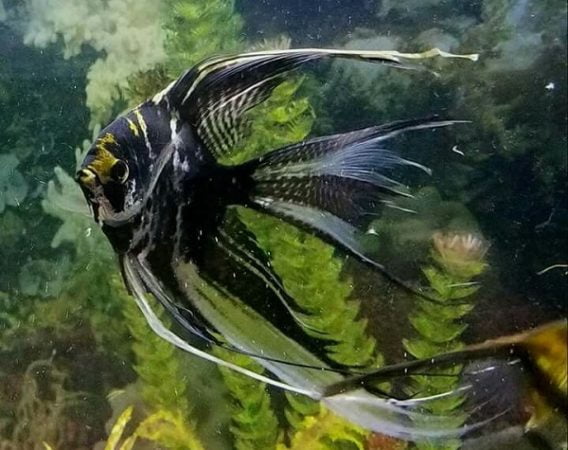
Veil and Super Veil: An angelfish with veiltail genetics has all fins longer and more flowing. If their fins are even more elaborate, they can be referred to as a super veil variety.
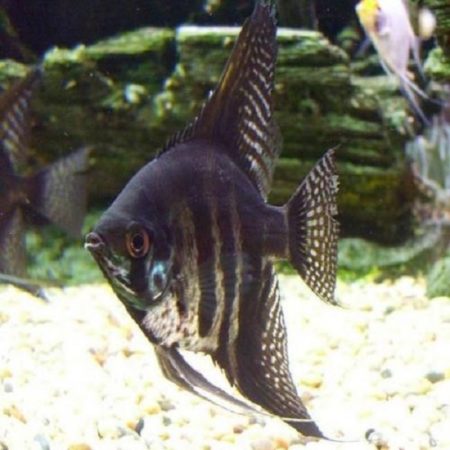
Black and Black Lace: The dark gene was the first color mutation discovered in captivity. When an angelfish has a dark gene, it is referred to as black lace. Their body is in dark, black color, and the fins have a beautiful lace pattern.
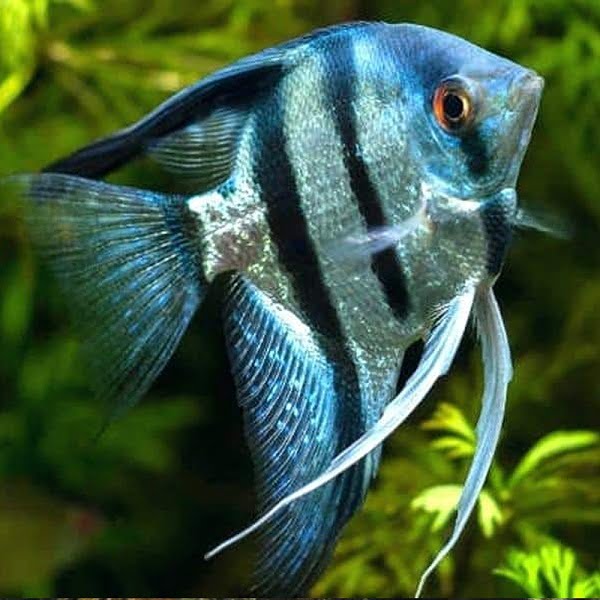
Zebra: Zebra angelfish are similar to silver angelfish, but they have four to six vertical stripes
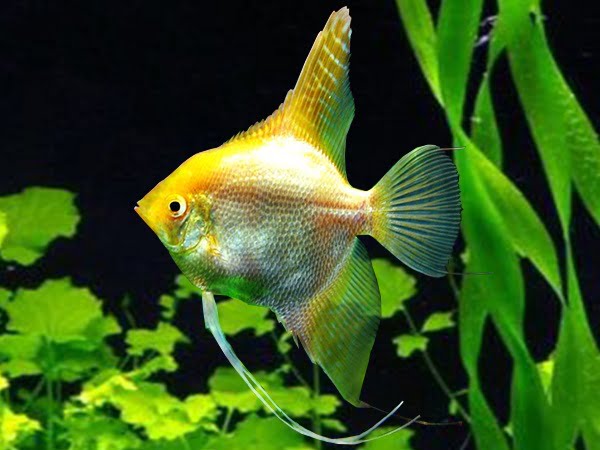
Gold: These angelfish are yellow-gold in color and do not have any black markings. Their faces, heads, and backs are often covered with yellow or orange markings.
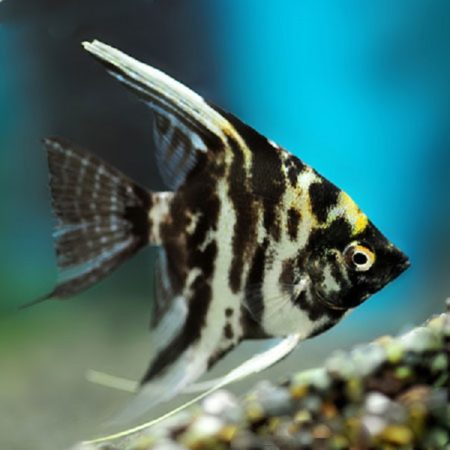
Marble: The black and silver patterns on a marble angelfish are marbleized rather than in vertical stripes.
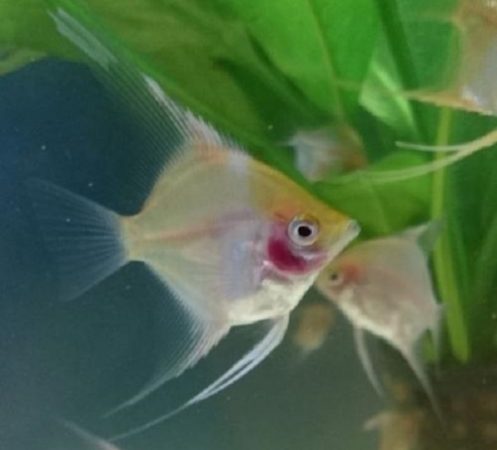
Blushing: The blushing trait in the young angelfish will cause their gill covers to be translucent, removing the dark bars. Because of the bright red gills showing through, the name “blushing” is introduced. However, their gill covers become opaque at their maturity stage.
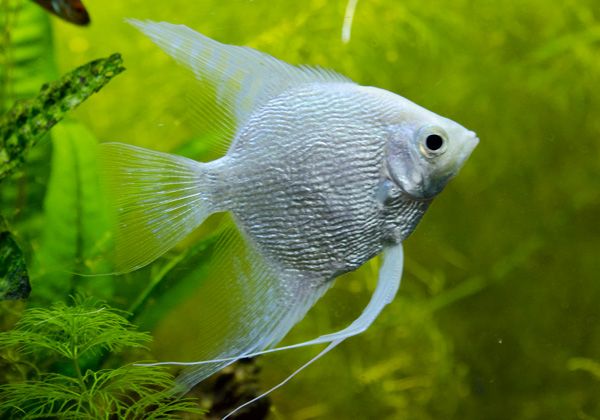
Platinum Angelfish: It is believed that Platinum Angelfish is a derivation of the Gold Angelfish after two copies of a recessive gene were merged. Platinum Angelfish display a brilliant white sheen as young fish, and as they grow, a greenish-blue tint only enhances this fish’s natural beauty.
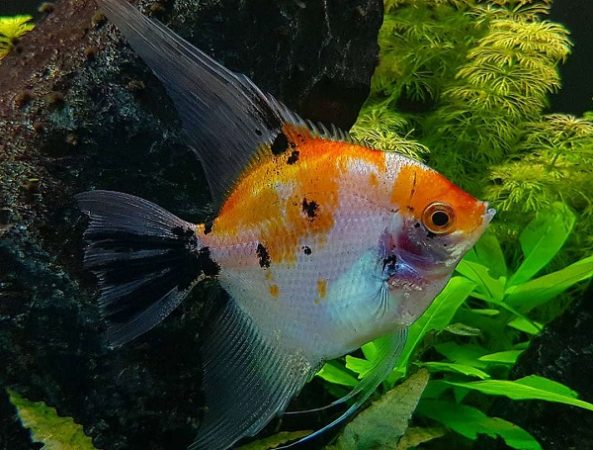
Koi: Gold marble blushings are known as koi angelfish. The red-orange pigment was originally visible only on the heads, but there have been varieties that display red-orange pigment throughout the body and the fins.
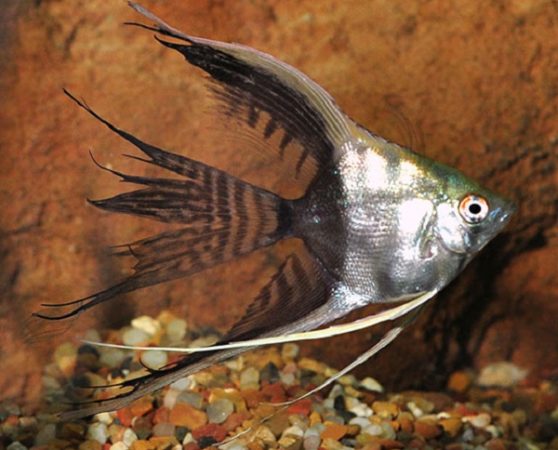
Half-Black: A half-black angelfish has a solidly black coloration on their back half. Their front half has a silver look, similar to that of a silver angelfish.
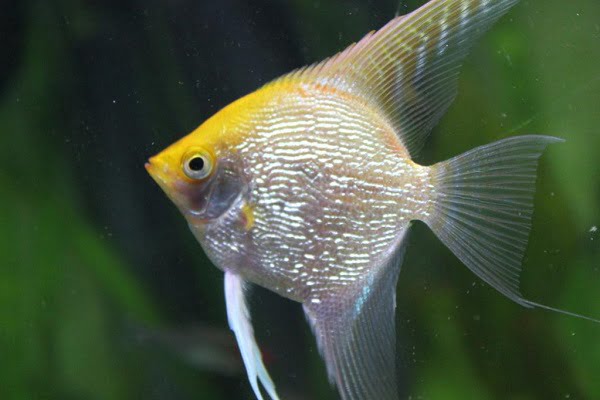
Pearlscale: Pearlscale is a scale mutation that can be seen on angelfish of all colors. The scales are crinkled like tinfoil and more noticeable on light fish than on darker ones.
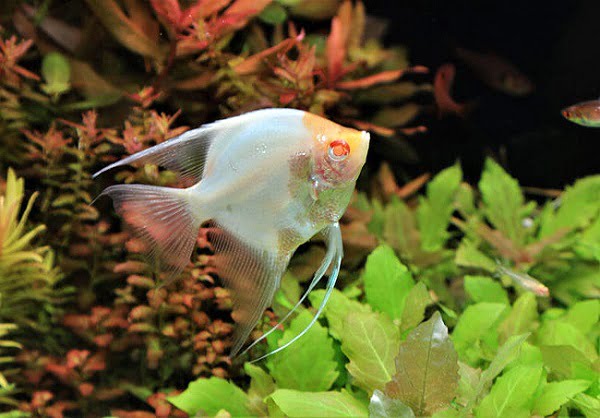
Albino: An albino angelfish lacks dark pigments, but their bodies may retain yellow or red coloration. Like other types of albino animals, the eye pupils of the albino angelfish are pink/red.
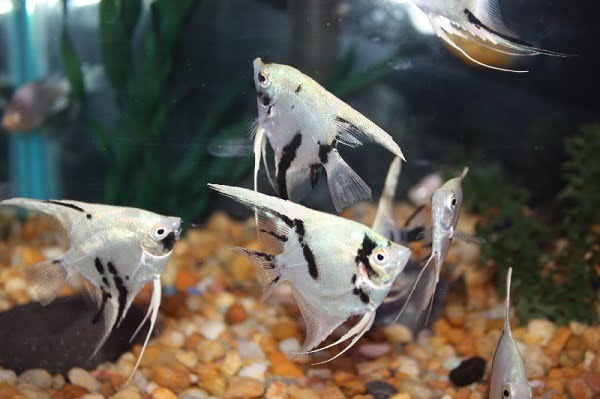
Panda: Angelfish in this color variation have white bodies with black patches resembling panda markings.
Size
The typical size of an angelfish can range between 2-12 inches tall, depending on the species and habitat.
In a small tank, they can reach a full size of 6 inches, while in a larger aquarium, their size can reach 10 inches.
In their natural habitat, angelfish thrive well and can perform a maximum size of 12 inches.
You can successfully raise angelfish from juveniles to full-grown adults by using the right size tanks, keeping the tank water clean, and feeding them a carnivorous diet more often than pellets.
Angelfish size chart
Different angelfish species display different sizes at maturity.
| Species | Size |
| Pterophyllum scalare (P. scalare) | 6 inches (15 cm) in length and 8 inches (20 cm) in height (including the fins) |
| Altum angelfish (P. altum) | 7 inches (18 cm) in length and 10-13 inches (25-33 cm) in height |
| Leopold’s angelfish (Pterophyllum leopoldi) | the smallest of the angelfish species, reaching 2 – 3.9 inches (5 -10 cm) in length |
Besides, their sizes vary among different types. The chart below shows the size of several common types.
| Angelfish types | Size (when mature) |
| Marble | 6 inches |
| Veil | 6 inches |
| Zebra | 6-7.5 inches |
| Ghost | 6-8 inches |
| Black lace | 8-10 inches |
| Gold | 6 inches |
| Blushing | 6-10 inches |
| Koi | 6-8 inches |
| Smokey | 6-7 inches |
| Albino | 6 inches |
Lifespan
When kept in ideal conditions, freshwater angelfish with quality genetics can live up to 10-12 years in captivity.
Besides, they can live for up to 15 years in the wild if they are not threatened by many predators.
Temperament & Behavior
In the wild, angelfish are primarily shy and seek refuge in densely populated areas, so you should try to replicate this in your aquarium.
They are often communal fish when young, but become territorial as they mature, especially around mating season. Any other fish that enters their territory will be chased away immediately.
They are also aggressive, big eaters and will swim to the top of the tank when seeing you approaching. Therefore, when you feed your fish during feeding time, make sure the less aggressive fish get their share.
Angelfish are generally active species. They are showy fish, swimming in the mid-level water of your tank and around aquarium plants. They are more active during the day than at night.
Pterophyllum species form schools, but they do not show social behavior toward other angelfish species. However, angelfish are not as aggressive as other cichlids and are unlikely to bully other species.
Compatibility
Angelfish are classified as semi-aggressive species because they are peaceful when having enough room for their own territories but get aggressive and fight with others, when being kept with too many fish of their kind, to defend their territory or claim a partner.
Besides, they can feed on smaller fish that fit their mouth, so it’s best to avoid housing them with small peaceful fish like small tetra and barbs.
In addition, fin-nipping fish such as barbs should not be added to avoid them harassing the angels and their flowing fins.
The most suitable angelfish tank mates include large peaceful and semi-aggressive fish like Dwarf Gourami, African Leaf Fish, Discus, etc., and other smaller fish that are too large to eat, such as Cory Catfish, Platy, Mollies, Swordtail, and larger tetras.
Tank Care
Tank size
A tall tank with at least 30 gallons is usually recommended for adult angelfish since they typically grow up to 4 to 8 inches long.
Generally, 30-gallon tanks are recommended for keeping a single or a pair of angelfish.
The tank size will need to be increased if you plan on building a community tank that includes angelfish. In this case, a tank capacity of 50 gallons is often recommended.
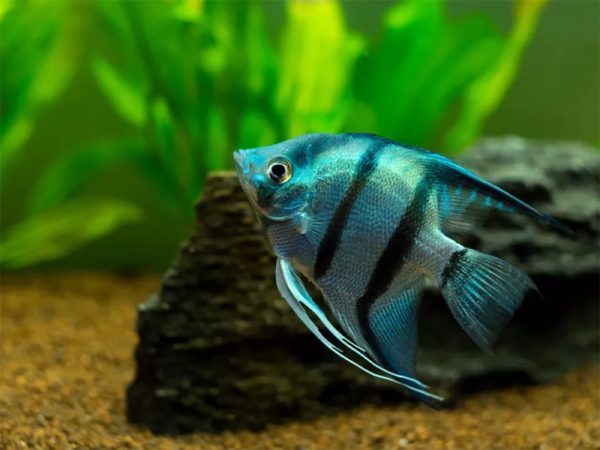
Water parameters
Angelfish prefer freshwater environments, but the pH should be between 6 and 8 while the water temperature should be between 78-85°F.
In your tank, fast water may create stressful conditions for Pterophyllum species because they’re not particularly strong swimmers. Fast-flowing water will force your angelfish to use more energy, leading to negative impacts on their growth and health.
To create a low water-current rate, you can add some under-gravel and sponge filters, allowing your fish to preserve more energy.
Setup & decorations
The angelfish tank should not be placed directly under the sun because the sun will overheat the tank water quickly.
If you’re going to keep more than a single angelfish, you should consider placing a tall plant in the center of the tank.
To support these fish’s activities, which are bottom-dwellers and active swimmers, it is important to include rocks as well as hide decorations in the tank.
You can find more useful information about setting up an angelfish tank in the following article: Best Freshwater Angelfish Tank Setup Ideas & Requirements
Diet & Feeding
Due to their carnivorous nature, angelfish require a balanced diet to grow to their maximum size.
As mentioned earlier, they are not picky eaters, meaning they can consume many types of fish food, including vitamin-enriched flakes, frozen, freeze-dried, and live foods. As they mature, they may also go after smaller fish like neon tetras.
Although these fishes do well on flakes and some other pelted diets, they prefer the natural diet of Bloodworms, shrimps, and Daphnia.
Spawning & Breeding
The angelfish reproduce at a higher rate than many other cichlids because they are very sexually active. Thus, to prevent an angelfish overpopulation in your tank, it is recommended that you remove the fries frequently.
In aquarium breeding, the P. scalare is one of the easier species to breed, although generations of inbreeding have resulted in many breeds losing their rearing instinct, which eventually introduces a tendency for parents to eat their fry. Meanwhile, the attractive P. altum is difficult to breed in an aquarium environment.
P. scalare breeding occurs in water with a pH of 7.5 or lower and a temperature of 78-80°F. The females will lay eggs on vertical or flat surfaces, like large leaves of aquatic plants.
In preparation for spawning, the pair selects a suitable medium on which to lay the eggs and spends a couple of days picking detritus and algae from the surface.
Females deposit eggs on spawning substrates, followed by males who fertilize them. Depending on the health and size of the female fish, a total of 100 to more than 1,200 eggs are laid during this process.
As soon as the eggs are laid, it is recommended to remove the parents to avoid them eating their fry.
With the air stone underneath the eggs and a gentle flow over them, a high hatch rate will be achieved. It is also possible to increase a successful hatch by pre-conditioning the parents with high-quality live foods.
Diseases
Angelfish are susceptible to parasitic diseases and fungi or bacterial infections. Some of the common diseases they can confront are:
- Hexamita – the hole in head disease: this is a slowly progressing disease caused by the Hexamita parasitic genus. Infected angelfish may exhibit symptoms such as weight loss, increased stool production, color change, skin decay, and finally produce holes-like lesions.
- Freshwater Ich: this is a protozoal parasite infection that causes white spots on freshwater fish bodies and gills.
- Columnaris: also known as cottonmouth disease. This is a bacterial infection caused by column-shaped bacteria in unsanitary conditions. The affected fish will have cotton-like lesions that lead to mouth rot and fin rot.
Video: The Best Beginner Fish? Top 10 Things About Freshwater Angelfish
FAQs
How many angelfish should be kept together?
In any tank, there must be at least two angelfish together. They should either be in a pair or a group. 5 to 6 individuals can be kept together in a tank for proper schooling.
Every angelfish requires at least a 10-gallon tank, so it’s always a good idea to analyze the tank size regarding their size and keeping number before putting them in your home aquarium.
Are freshwater angelfish aggressive?
Angelfish are generally peaceful when young, but tend to display aggression as they mature. Additionally, because they are such active, feisty species, they can be aggressive and territorial and are usually not very friendly tankmates. As a result, keeping angelfish requires much caution and understanding.
Are freshwater angelfish easy to keep?
In an aquarium at home, angelfish are a good choice. By providing the right environment, caring for them is fairly easy. Make sure to maintain the temperature and pH levels at the correct level in the tank. Then, you should feed your angelfish a balanced diet and keep their tanks clean.
Conclusion
Angelfish are great fish and easy to keep. Though they do express aggression towards other species, they are peaceful when being fed well and have enough space for swimming.
If you have enough space and experience caring for other freshwater fish, you should consider getting an angelfish for your aquarium. If your tank already has shy, nervous fish or if it is overcrowded with fish, don’t get an angelfish.
Despite the occasional territorial behavior, angelfish have a wide-range color variety and are quite hardy, making them a wonderful fish that you should have in your home freshwater aquarium.
References:
https://en.wikipedia.org/wiki/Pterophyllum

Annette M. Chaney is an experienced marine biologist with over 20 years of experience as an aquarist and fishkeeper. She started her first aquarium at a young age, filling it with frogs and goldfish obtained from the ten-cent pet store.
Annette grew up caring for and breeding African Cichlids, which led to a hobby in high school that doubled as a profitable means. Attending Reed College gave her time to solidify herself as an accomplished aquarium caretaker with an eye for sales. After that, from 2009 – 2013, she studied at Roger Williams University – one of the most prestigious universities for Aquaculture and Aquarium in USA. She is the founder of AquariumCircle since 2010.
